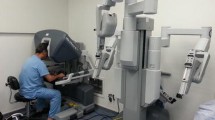Abstract
Advances in communication technologies have paved the way for telemedicine to transform the delivery of medical care throughout the world. Coinciding developments in minimally invasive surgery and in particular teleoperated robotic surgical systems will allow the surgeon to deliver expert care in remote locations. This study presents a systematic review of telemedicine, focusing on telerobotic surgical systems. A brief historical review of telemedicine and telerobotics is provided, including a description of the various subtypes of telemedicine. Currently available systems and recent experimental utilization, including long-distance remote telesurgery, are discussed. Experimental telerobotic surgical systems and future developments in the field are reviewed and the potential applications are considered. Future challenges to the implementation and opinions on the future direction of telerobotics are provided in this review.

Similar content being viewed by others
References
SAGES Group (2000) Guidelines for the surgical practice of telemedicine. Society of American Gastrointestinal Endoscopic Surgeons. Surg Endosc 14(10):975–979
Ryu S (2012) Telemedicine: opportunities and developments in member states: report on the second global survey on eHealth 2009 (Global Observatory for eHealth Series, Volume 2). Healthc Inform Res 18(2):153–155
Barold SS (2003) Willem Einthoven and the birth of clinical electrocardiography a hundred years ago. Card Electrophysiol Rev 7(1):99–104
Eadie LH, Seifalian AM, Davidson BR (2003) Telemedicine in surgery. Br J Surg 90(6):647–658
Augestad KM, Lindsetmo R-O (2009) Overcoming distance: video-conferencing as a clinical and educational tool among surgeons. World J Surg 33:1356–1365
Santomauro M, Reina GA, Stroup SP, L’Esperance JO (2013) Telementoring in robotic surgery. Curr Opin Urol 23(2):141–145
Institute of Medicine (1996) Telemedicine: a guide to assessing telecommunications for health care. The National Academies Press, Washington, DC
Gruessner V (2015) The history of remote monitoring, telemedicine technology. Mhealthintelligence. https://mhealthintelligence.com/news/the-history-of-remote-monitoring-telemedicine-technology. Accessed 27 May 2018
Vinches A (2018) What you didn’t know about the history of telemedicine. Sightcall. https://sightcall.com/history-telemedicine/. Accessed 27 May 2018
Lanfranco AR, Castellanos AE, Desai JP, Meyers WC (2004) Robotic surgery: a current perspective. Ann Surg 239(1):14–21
Kwoh YS, Hou J, Jonckheere EA et al (1988) A robot with improved absolute positioning accuracy for CT guided stereotactic brain surgery. IEEE Trans Biomed Eng 35:153–161
Davies B (2000) Review of robotics in surgery. Proc Inst Mech Eng H 214(1):129–140
Satava RM (2002) Surgical robotics: the early chronicles: a personal historical perspective. Surg Laparosc Endosc Percutaneous Tech 12:6–16
Haidegger T, Sandor J, Benyo Z (2011) Surgery in space: the future of robotic telesurgery. Surg Endosc 25(3):681–690
Aracil R, Buss M, Cobos S, Ferre M, Hirche S, Kuschel M, Peer A (2007) The human role in telerobotics. Springer Tracts Adv Robot 31:11–24
Avgousti S, Christoforou EG, Panayides AS et al (2016) Medical telerobotic systems: current status and future trends. Biomed Eng Online 15(1):96
Simon IB (1993) Surgery 2001. Concepts of telepresence surgery. Surg Endosc 7:462–463
Gambadauro P, Torrejon R (2013) The, “tele” factor in surgery today and tomorrow: implications for surgical training and education. Surg Today 43(2):115–122
Raison N, Khan MS, Challacombe B (2015) Telemedicine in surgery: what are the opportunities and hurdles to realising the potential? Curr Urol Rep 16(7):43
Hung AJ, Chen J, Shah A, Gill IS (2018) Telementoring and telesurgery for minimally invasive procedures. J Urol 199(2):355–369. https://doi.org/10.1016/j.juro.2017.06.082
Hinata N, Miyake H, Kurahashi T, Ando M, Furukawa J, Ishimura T et al (2014) Novel telementoring system for robot-assisted radical prostatectomy: impact on the learning curve. Urology 83:1088–1092
Marescaux J, Leroy J, Gagner M et al (2011) Transatlantic robot-assisted telesurgery. Nature 413:379
Marescaux J, Leroy J, Rubino F et al (2002) Transcontinental robot-assisted remote telesurgery: feasibility and potential applications. Ann Surg 235(4):487–492
Anvari M (2004) Robot-assisted remote telepresence surgery. Surg Innov 11(2):123–128
Sterbis JR, Hanly EJ, Herman BC (2008) Trans- continental telesurgical nephrectomy using the da Vinci robot in a porcine model. Urology 71:97
Wirz R, Torres LG, Swaney PJ (2015) An experimental feasibility study on robotic endonasal telesurgery. Neurosurgery 76:479
WinterGreen Research. Surgical Robots Market Shares, Strategies, and Forecasts, Worldwide, 2015 to 2021
da Vinci Products FAQ (2018) Intuitive Surgical. http://phx.corporate-ir.net/phoenix.zhtml?c=122359&p=irol-faq. Accessed 28 May 2018
Tognarelli S, Salerno M, Tortora G et al (2015) A miniaturized robotic platform for natural orifice transluminal endoscopic surgery: in vivo validation. Surg Endosc 29:3477
Reichenbach M, Frederick T, Cubrich L et al (2017) Telesurgery with miniature robots to leverage surgical expertise in distributed expeditionary environments. Mil Med 182(S1):316–321
Garcia P, Rosen J, Kapoor C, Noakes M, Elbert G, Treat M, Ganous T, Hanson M, Manak J, Hasser C, Rohler D, Satava R (2009) Trauma pod: a semi-automated telerobotic surgical system. Int J Med Robot Comput Assist Surg. 5(2):136–146
Lum MJH, Friedman DCW, Sankaranarayanan G et al (2008) Objective assessment of telesurgical robot systems: telerobotic FLS. Stud Health Technol Inform 132:263–265
Strickland E (2017) In flesh-cutting task, autonomous robot surgeon beats human surgeons. IEEE spectrum. https://spectrum.ieee.org/the-human-os/biomedical/devices/in-fleshcutting-task-autonomous-robot-surgeon-beats-human-surgeons. Accessed 27 May 2018
Bonaci T, Herron J, Yusuf T, Yan J, Kohno T, Chizeck HJ (2015) To make a robot secure: an experimental analysis of cyber security threats against teleoperated surgical robots. http://arxiv.org/abs/1504:04339
Author information
Authors and Affiliations
Corresponding author
Ethics declarations
Conflict of interest
The authors declare that they have no conflict of interest.
Research involving human participants and/or animals
All procedures performed in studies involving human participants were in accordance with ethical standards of the institutional and/or national research committee and with the 1964 Helsinki declaration and its later amendments or comparable ethical standards.
Informed consent
For this type of study formal consent is not required.
Funding
No funding was obtained for this project.
Rights and permissions
About this article
Cite this article
Evans, C.R., Medina, M.G. & Dwyer, A.M. Telemedicine and telerobotics: from science fiction to reality. Updates Surg 70, 357–362 (2018). https://doi.org/10.1007/s13304-018-0574-9
Received:
Accepted:
Published:
Issue Date:
DOI: https://doi.org/10.1007/s13304-018-0574-9




